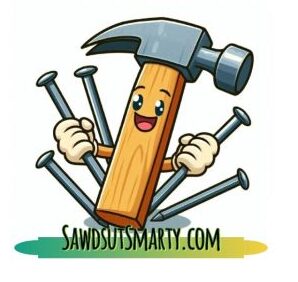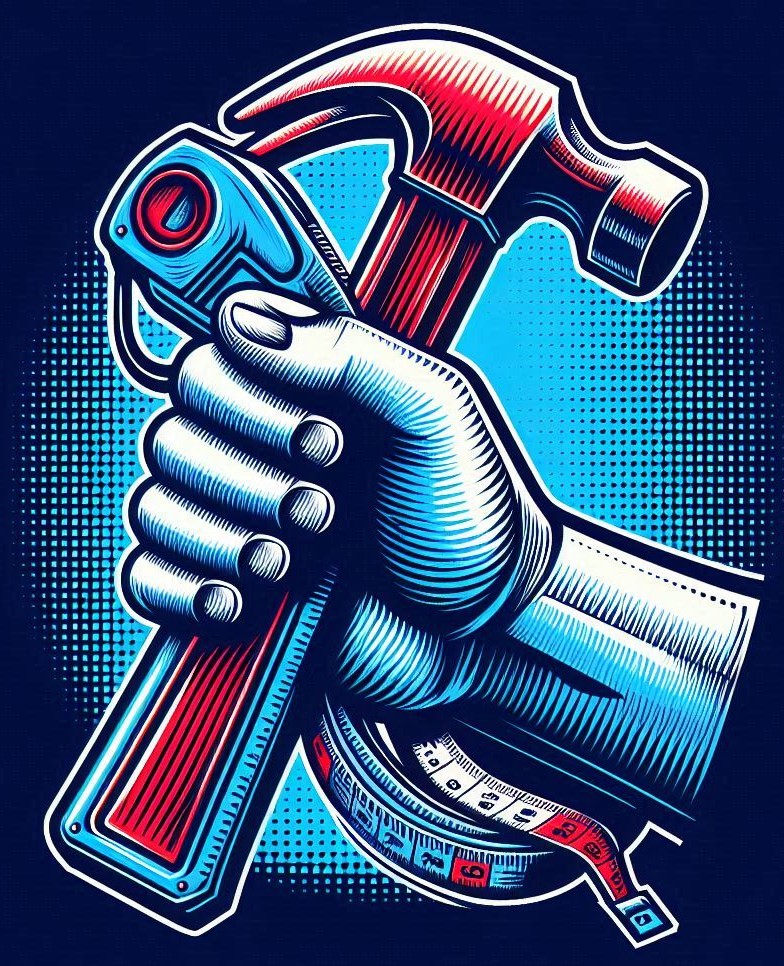Diving into the world of wood projects for beginners can feel a bit like getting lost in a labyrinth of tools and techniques. But here’s the deal: it doesn’t have to be overwhelming. Starting small with basic knowledge about wood types and tools can make a world of difference.
If you are new to the world of wood projects for beginners, allow me (Wayne) to say welcome…
Before you even think about picking up that saw, let’s talk safety. Keeping your workspace organized, knowing your tools, and understanding basic safety measures can prevent accidents. Trust me, safety goggles and gloves are your best friends in the workshop.
So why take up woodworking? Aside from crafting some cool wooden items, it’s a fantastic way to de-stress and refine skills like problem-solving and creativity. Plus, the satisfaction of building something with your own hands? Priceless.
It’s easy to fall into the trap of thinking you need all the high-end tools to get started. Nope! All you really need are a few basic tools, permission to make mistakes, and a willingness to learn from them. Everyone started somewhere, so you’re in good company.
Simple Woodworking Projects: Starting Small
Getting your hands on easy woodworking projects can give you that confidence boost to tackle bigger tasks down the road. When you’re starting, think small and simple. You don’t need to channel your inner master craftsman just yet.
One of the first projects I always suggest is a basic wood birdhouse. It’s not just a satisfying project, it’s practical too. Begin by selecting a good piece of wood; maple or walnut are great choices. Measure, cut, sand, and finish to turn a plain wood slab into kitchen magic.
If you’re up for a little home decor, how about crafting a simple wooden picture frame or maybe even some wall art? Measure your dimensions, cut your wood pieces, and nail them together. This project introduces you to angling and joining without overwhelming you.
Feeling a bit more adventurous? A mini wooden planter box makes a neat table centerpiece or a thoughtful gift. With just a few planks, nails, and a hammer, you can assemble a charming box that adds a touch of nature indoors.
Remember, with each project comes new skills. Don’t rush the process and celebrate each completed piece. Woodworking isn’t just creating something tangible; it’s about enjoying each step of crafting something from bare basics.

Easy Woodworking for Young Creators
Woodworking isn’t just an adult’s game. It’s an awesome way for kids to get creative, build skills, and have a whole lot of fun. Projects tailored for little hands don’t just entertain; they teach important lessons in patience and precision.
One classic kid’s project is the wooden birdhouse. With a little help from an adult, kids can hammer together pre-cut pieces and decorate it as they like. The joy of seeing birds use their creation is unforgettable.
Another exciting project could be a simple wooden toy car. It’s about sawing, sanding, and maybe even painting. This project demands supervision, but it’s easily adjustable to be age-appropriate and safe.
Safety in the workshop is key. Ensure kids wear protective gear, use age-appropriate tools, and always have adult supervision. Setting down some firm ground rules beforehand helps keep the experience both safe and enjoyable.
** Here’s a little transparency: Our website contains affiliate links. This means if you click and make a purchase, we may receive a small commission. Don’t worry, there’s no extra cost to you. It’s a simple way you can support our mission to bring you quality content.**
Innovative Wood Storage Solutions
Creating smart wooden storage solutions can be a lifesaver when you’re tight on space and big on stuff. Don’t worry if you’re just starting out; these projects cater to beginners eager to learn while solving storage woes.
Begin with a simple DIY shelf. All you need are a few wooden planks and some brackets. It’s a straightforward project that lends a hand in organizing your space while giving you a grasp of measuring and cutting.
For something a bit more enclosed, try crafting a wooden box with a lid. This project introduces basic joinery and hinge installation and is perfect for tucking away clutter. Plus, it offers a satisfying combo of challenge and simplicity.
Ever thought about sliding wood storage? It might sound advanced, but breaking it down step-by-step makes it approachable. Consider building a sliding lid box. It’s all about guiding the slides smoothly using grooved wooden sides.
These projects are not just about storage; they’re about learning to see wood as a canvas for solving everyday problems. Each piece you craft serves a purpose, boosting both your skills and your home organization in one go.
As an Amazon Associate, I earn from qualifying purchases.
Here are a few excellent resources for more information on woodworking.
Woodworking Plans and Projects
Woodworking Projects for Beginners
Here’s another great source for Woodworking Plans and Tutorials:
Free Resources and Idea Pools: Inspirations for Novices
Finding free woodworking plans online is like striking gold for beginners eager to expand their skill set without shelling out cash. The internet is buzzing with resources just waiting to be discovered by enthusiastic craftspeople.
Websites like Instructables, Ana White, and Woodwork City offer free plans that cater to all skill levels. They break down projects into manageable steps, making navigation a breeze for newcomers.
Video tutorials on platforms like YouTube are another hit. Watching someone else work through each step provides a visual guide that written instructions sometimes can’t match. It’s like having a mentor without leaving home.
Consider joining online forums or woodworking groups on social media. They’re filled with seasoned hobbyists eager to share advice, critique your work, and cheer you on. It’s an interactive way to learn and grow beyond the solitary confines of your garage or shed.
Remember, the more you engage with these resources, the more confident you’ll become in exploring new projects and techniques.





This was such a motivating read! I really appreciate how you laid out beginner-friendly wood projects in a way that feels doable and not overwhelming. Sometimes woodworking can seem intimidating if you’re just getting started, but your step-by-step approach makes a big difference.
I’ve done a couple of small pallet projects and built a basic planter box last summer—it was a great way to learn how to measure and cut properly without needing expensive tools. That hands-on experience gave me a lot more confidence for future builds.
One question I had: do you have a go-to list of essential tools that beginners should invest in first? I’m still figuring out which ones are truly worth buying early on and which can wait.
In my opinion, woodworking is one of the most satisfying DIY hobbies—you get to build something useful and learn valuable skills along the way. Thanks for making it more accessible for those of us just starting out!
Thank you for your comment, Tommy Potter… I’m glad you can appreciate my post. Experience is the best teacher, no doubt. I do not have a go-to list of essential tools that beginners should invest in yet, but you just gave me a great idea for another article to post! Thanks!!
Approach it like this: You need something to measure with; You need something to cut with; You need something to sand with; and lastly, you need something to fasten with. That should be a good starting point.
Thanks again… Wayne
I really appreciate how this guide breaks down beginner wood projects into manageable steps, especially helpful for those of us who are new to DIY. One thing I’m curious about is how to choose the right type of wood for each project. For instance, should softwoods always be preferred for starters, or does it depend on the toolset available? Also, how critical is wood grain direction when assembling basic pieces like shelves or boxes? From my experience, a small error in measurement or cutting angle can really throw off a project, so I’d love to know if you recommend any beginner-friendly tools that help improve precision.
Thank you for your comment Slavisa… Choosing the right type of wood is crucial. For beginners, softwoods like pine or cedar are typically easier to work with, as they require less effort to cut and shape. The toolset you have might also influence your choice. For example, robust tools can handle hardwoods better, but for simplicity and ease, sticking with softwoods usually offers a more forgiving experience.
Grain direction isn’t just a minor detail—it can determine how strong and smooth your project turns out. Align the grain with the project’s dimensions, especially when crafting shelves or boxes, to enhance strength and avoid awkward warping or splitting. This little detail adds structural stability and maintains the aesthetic of your creation.
To start off on the right foot, beginner-friendly tools are your best friends. Look for things like a beginner-level jigsaw or a good-quality tape measure with easy-to-read increments. These tools can significantly boost your ability to create pieces with finesse. Don’t underestimate the impact of having the right equipment on your DIY journey.
Thanks again… Wayne